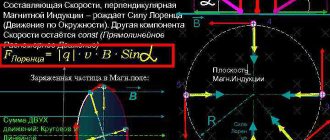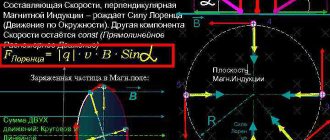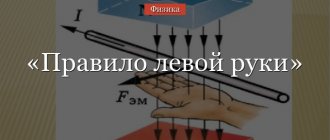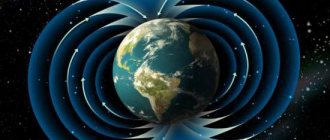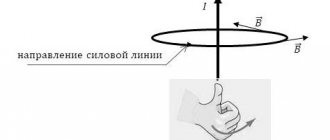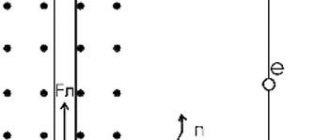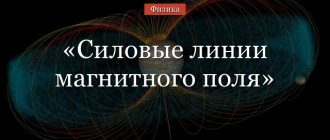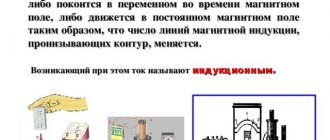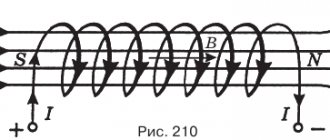French physicist Marie Ampere surprised the world with many amazing discoveries. In particular, he proved the interaction of a conductor in a magnetic field with the strength of a given magnetic field in the presence of an electric current. From the school curriculum we know that current is the ordered movement of charged particles (electrons); accordingly, the electromagnetic field also affects an individual charged particle. This action is known in science as the Lorentz force; there is a certain formula in physics to determine its modulus.
History of discovery
Scientists first tried to determine what electromagnetic force is in the 18th century. Then experts suggested the following: the inverse square law can be applied to the force concentrated on the magnetic poles and on objects with a charge. However, it was not possible to practically prove this statement. This was done at the end of the 18th century by Charles Augustine de Coulomb, using a device for measuring minor forces, namely a torsion balance.
In the first half of the 19th century, discoveries were made that became the basis for the further development of the theory of electromagnetic fields. The following has been proven - the compass needle is under the influence of the magnetic force of the earth; in addition, a formula has been derived and proven for calculating the angular dependence between various current elements. These two discoveries became the basis for the theoretical developments of Michael Faraday; the scientist’s work was supplemented by calculations and specific justifications by Lord Kelvin and James Maxwell. The latter introduced the world of physics to Maxwell's field equation, which was used by Jay Thompson, and derived the value of the electromagnetic force acting on every charged moving particle. He formulated his theoretical conclusions with the formula: F = q/2 vx B. However, it turned out that it was not entirely correct.
Only at the end of the 19th century, the Dutch scientist Hendrik Lawrence managed to derive the correct formula; it is still used today, it is named after the scientist. The unit of measurement for Lorentz force is Newton.
Meaning and Definition
The Lorentz force law describes the influence of E and B on a point charge, but such influence does not show the whole picture. Charged particles do not simply drift in a uniform electromagnetic field. They may be subject to other influences, such as gravity. In real materials, the physicist's conclusions are not suitable for describing the collective behavior of such particles, as in principle and for calculation, since bodies not only react to the E and B fields, but also generate them.
Complex transport equations must be solved to determine the temporal and spatial reaction of charges, for example, the equalities:
- Boltzmann;
- Fokker - Planck;
- Navier-Stokes.
For example, to solve questions on hydrodynamics, electrohydrodynamics, superconductivity and evolution of stars, a whole physical apparatus (Green-Kubo formulas) has been developed.
For greater accuracy, it should be clarified that the Lorentz force means the following empirical statement: F on a test charge at a given point and a given time is a specific function of charge q and velocity V, which can be parameterized by exactly two vectors E and B in the form F = q ( E + vx B).
This is true even for particles approaching the speed of light. Thus, two vector fields (magnetic and electric) are determined throughout space and time regarding what force the test charge will receive.
Actually, this is only a definition in principle, because a real particle (as opposed to a hypothetical one) will generate its own finite E and B fields, changing the electromagnetic force it experiences. In addition, when the charge has acceleration, as if it were forced to move along a trajectory curved by some external agents, radiation emits from it, causing deceleration. These effects occur through both direct and indirect effects. Among other things, gravity and other forces must be taken into account.
What does force mean and its formula
The Lorentz force is usually called the force that affects an electron that is moving and located in a magnetic field. We are talking about a combination of two forces - magnetic, electric, concentrated on a charge. The Lorentz force is determined by the following values:
- induction;
- amount of charge;
- the speed of movement of the particle.
The direction of the charged particle is orthogonal to the plane where the velocity vectors are located. For the Lorentz force in physics, there is a resultant force - this is the Ampere force.
To clearly demonstrate the required force, let's remember the experiment that you were probably shown in physics class - with a magnet, metal filings, a sheet of paper. The teacher brought a magnet to the sawdust from below, through the paper, and they lined up in clear lines. They form the force field of the magnet. It is noteworthy that this is a closed space without beginning or end. We are talking about a vector quantity that, under any circumstances, rushes towards the north pole of the magnet. If a charged particle enters the field, the trajectory changes. The angle of deflection is determined by the speed of the particle, as well as the force that affects the electron. This is the desired Lorentz force; to calculate it, use the formula: FL=qVB, here:
- q – charge strength (indicated in Coulombs);
- V – speed of charge movement (indicated in m/s);
- B - field induction (denoted in Tesla).
The definition of strength, as well as the formula, proposed at the end of the 19th century, are still relevant today.
Direction of force
The indication of the Lorentz force becomes the opposite if two conditions are met:
- when the sign of the charge also becomes opposite;
- the directions of other vectors remain unchanged.
The trajectory of an electron is usually called a helical line.
When does it occur
The magnetic field parameters remain unchanged if the charged particle is stationary. Similarly, the conductor is not affected by the Ampere force when there is no current.
To determine the Lorentz force modulus, the following conditions will need to be met:
1. the presence of a charge on the particle;
2. presence of a magnetic field;
3. the particle must move.
If one of the three conditions is not met, there is no power.
Task examples
Problem 1
A charge of 0.005 C, which moves in a magnetic field with an induction of 0.3 T, is subject to the Lorentz force. Calculate it if the speed of the charge is 200 m/s, and it moves at an angle of 450 to the lines of magnetic induction.
| Given: q = 0.005 C B = 0.3 T v = 200 m/s α = 450 | Solution: In the conditions of the problem there is no mention of the electric field, so the Lorentz force can be found using the following formula: FL=qvBsinα=0.005×200×0.3×sin 450 =0.3×22=0.21 N |
Problem 2
Determine the speed of a body that has a charge and which moves in a magnetic field with an induction of 2 T at an angle of 900. The magnitude with which the field acts on the body is 32 N, the charge of the body is 5 × 10-3 C.
| Given: q = 0.005 C B = 2 T FL = 32 N α = 900 | Solution: To find the charge speed, it is necessary to slightly modify the formula for finding the Lorentz force: FL=qvBsinαv=FLqBsinα v=320.005×2×sin900=320.01×1=32000ms=32 km/s |
Electromagnetic induction, magnetic flux
The term magnetic induction refers to the physical property of a magnetic field. This quantity is vector, and the symbol B is used to denote it. Induction characterizes the force affecting a charged particle that moves in a magnetic field. It is important to remember that the force, as well as the direction of motion of the electron, are perpendicular to each other.
Induction occurs when a magnet moves in a coil and a current is produced. Consequently, the magnetic flux increases proportionally.
Induction is explained as follows: the metal structure of the coil is crystalline, electrical charges are located here. If there is no influence of the magnet on the coil, these charges do not move. When it enters a magnetic field, a charge speed is created as the electrons begin to move. A current is formed in the conductor, its strength is determined by the parameters of the magnet and conductor.
Good to know! If a conductor is surrounded by a magnetic field, the electrons are shifted at a certain angle and are placed parallel to the lines of force.
Background: Laplace's demon
In 1814, the great French scientist Pierre-Simon Laplace created a demon that was destined to become the subject of scientific debate for many years.
The fictional demon knew the position and speed of every particle in the Universe at every moment in time and, knowing all the laws of physics, could predict the future of each particle and describe its past. Question: is such a demon conceivable at least theoretically? The successes of modern science suggested that yes: the orbits of the planets were calculated, the appearance of comets were predicted, random events were described by the theory of probability.
Later, however, Laplace's demon was subjected to severe criticism. After the development of quantum mechanics and the discovery of Heisenberg’s uncertainty principle (it is impossible to accurately measure the speed and coordinates of a particle at the same time), it became clear that quantum systems are not subject to the demon: they have a fundamental unpredictability.
Subsequently, it was also noted that the existence of a demon would contradict the laws of thermodynamics, that in principle it would not have enough information power for knowledge and calculations, even if it used all the resources of the Universe.
However, the demon did not completely give up his position. In fact, let us imagine a completely deterministic (predetermined, devoid of randomness) system (classical, without quantum effects). If we know all the laws governing its behavior (no matter how complex they are), we know all the necessary parameters and have the necessary computing power (that is, we have Laplace’s demon at hand - read: a supercomputer), then for such a system we can completely predict behavior?
There is one caveat. All our measurements will contain some error. Variables stored in computer memory will have limited precision. That is, you will have to use approximate data. Well, okay: we don’t need infinite accuracy, approximate predictions are quite enough. Does the source data contain an error in the fifth digit? A prediction error in the fifth digit will suit us just fine.
So, is it possible, for example, to predict the weather? At least approximately? At least in some limited area, but for a more or less decent period?
Law of Electromagnetic Induction
In simple words, one of the basic laws of physics can be formulated as follows: changes in the magnetic field, provided that it crosses the contour, are accompanied by the appearance of an electromotive force. It is proportional to the rate of change of the magnetic field. It doesn’t matter what provoked such changes in the magnetic field.
The law was proposed by Michael Faraday at the beginning of the 19th century. It is on Faraday's law that the work of transformers, generators, and chokes is based. The circuit is a coil of wire, the magnetic field forms a magnet. To measure the electromotive force, the wire is connected to a voltmeter.
Let's consider two options:
- the magnet is stationary above the coil - a constant field is formed, the parameters of which do not change, and accordingly, the electromotive force does not arise;
- the position of the magnet changes - any movement of the magnet causes changes in the field, this is the source of the appearance of electromotive force and voltage, EMF measurements can be carried out while the magnet is moving.
The EMF in the circuit generates a current, its orientation is determined using Lenz's rule, formulated as follows - the current that appears during changes in the magnetic field passing through any circuit restrains these changes. Thus, when a magnet acts on the coil, the following happens - the magnetic flux increases, a current and a magnetic field appear, which prevents the increase in the magnet's field.
Good to know! To understand where the current is moving, you need to screw the gimlet in the direction of the north pole; a magnetic field is formed in a similar direction. This means that the current flows parallel to the clockwise direction.
If the magnet does not act on the coil, the following happens - the magnetic flux decreases, accordingly, the magnetic field of the current restrains the decrease in the magnet's field. To determine in which direction the current is moving, the gimlet is unscrewed, its movement indicates where the current is directed, namely, in the opposite direction from the clockwise direction.
Secret Heretic
Newton began to have disagreements with the Church of England while he was studying at Cambridge. The future scientist early began to study religious works, delve into the history of Christianity and rethink church dogmas from the position of rationalism. Even in his youth, he came to the conclusion that the Catholic and Anglican churches were distorting the word of the Lord. In his opinion, the early church fathers altered the information that God passed on to his disciples, but this knowledge is still preserved in ancient texts. Newton denied the concept of the Trinity based on the commandment “Thou shalt have no other gods before Me.” He considered belief in the Holy Spirit to be heresy, and the idea of the Trinity to be blasphemy.
Photo: Erich Lessing / Album/EAST NEWS
However, the scientist never publicly showed his religious disagreement, since for such objections he could be considered a heretic, expelled from the scientific world, and even sentenced to death. The Church in those days considered heretics a threat to society and brutally dealt with dissenters.
Experiments in alchemy convinced Newton that everything was controlled by the hand of God. He also saw God’s special providence in the structure of the Universe and the structure of substances. The scientist sought to comprehend it on his own: he spent decades searching for secret encrypted knowledge in biblical texts, in particular in the Revelation of John the Theologian. He even calculated the date of the Apocalypse - Judgment Day: according to his calculations, it falls in 2060. The fact that in his youth Newton considered himself a chosen theologian is indicated by his pseudonym - Jeova sanctus unus, composed of Isaacus Neuutonus. Translated, it means “holy and one Jehovah.” In his secret writings, Newton more than once poured out his anger at the monks who ruined Christianity.
From constant discussions about God, ether - a secret matter inaccessible to our senses - ultimately a brilliant idea was born about the invisible force that controls the planets and attracts bodies to the earth - about gravity. From religious thoughts, the foundations of mechanics and the law of universal gravitation gradually took shape.
In the BBC film Isaac Newton. The Last of the Magicians” says that the scientist kept his secrets all his life and only on his deathbed did he reveal his dangerous heretical beliefs to his few friends. He refused the last communion, saying that he did not want to join the fold of a rotten church.
Newton's worldview in the 21st century looks like complete obscurantism. However, it is worth considering that in the 17th century, chemistry had not yet been separated from alchemy, and university professors were required to take up a church position and believe in God. So 350 years ago, Newton was a fairly typical scientist of his time, who, along with useful scientific experiments, came up with recipes for the plague based on powder from toads and considered how to stick a long needle deeper under the eyeball in order to better study the perception of color and light.
How did Newton manage to remain silent about his secret knowledge after living for 84 long years? The curator of manuscripts John Keynes put it this way: “Newton was deeply neurotic... the most extreme example. His deepest instincts were occult, esoteric, semantic - with a deep disgust for the world, a paralyzing fear of exposing his thoughts, his beliefs, his discoveries in all their nakedness to the scrutiny and criticism of the world... He viewed the Universe as a cryptogram created by the Almighty... a mystery, he believed , will be revealed to the initiate."
Blame it on gravity
A fallen apple or plagiarism: how Newton discovered the law of universal gravitation
Current magnetic field energy
The parameter indicates how much work is done by the current in the conductor to form a magnetic field. The value is directly determined by the inductance of the conductor around which the field is formed.
To calculate the energy, there is a formula equal to the product of the circuit inductance, the current squared, the resulting result is divided by two: W = LI2/2.
Chaos theory
Lorenz's observations force us to experience two shocks.
First, it turns out that Laplace’s demon can be powerless even in front of a not very complex deterministic system. Where everything seems predetermined, chaos suddenly arises. The second shock is that in this chaos, it turns out, order is hidden. Unexpected, strange, poorly understood, representing “a subtle structure hidden in a chaotic flow of information” (J. Gleick), but all the more interesting. The Lorentz attractor does not solve the problem of prediction, but its very existence is worthy of study.
The search for such manifestations of order in chaos is the focus of a relatively young science – chaos theory. It did not arise instantly and does not have one creator. Its foundations were laid in the works of Poincaré, Kolmogorov, Arnold, Lyapunov, Landau, Smail, Mandelbrot, Feigenbaum and dozens of other talented scientists who either saw something that no one had seen before, or were able to describe what others saw.
One of the key moments (not immediately appreciated, by the way) in its emergence is considered to be the day when Edward Norton Lorenz, a weather lover and persistent seeker of the strange, introduced variable values rounded to three decimal places into his model.
Movement of a particle in a magnetic field
For clarity, let's consider several options. The direction of the particle is perpendicular to the field; it moves in a circle, the radius of which is constant.
The Lorentz force is directed radially towards the central point of the circle, and radial acceleration appears. If we apply Newton's second law, we obtain the following equation: Fl = maT = mv2/R. From this equation we obtain the following: mv2/R = qvB. Using this expression, we can derive a formula for calculating the angular velocity of the electron: w = v/R = qB/m.
If in this expression the values q, m, B are unchanged, the angular velocity also remains unchanged. The radius of movement is affected only by speed.
The Lorentz force forms acceleration and is directed into the circle. The direction of the positively charged particle and the screw are the same, but the orientation of the screw and the magnetic field are opposite. Accordingly, the negatively charged particle rotates in the opposite direction.
The Lorentz force is zero provided that the motion of the particle and the induction vector are parallel. The electron moves uniformly and in a straight line.
The third option is that the electron moves in the field, the velocity vector forms an angle with the magnetic field. Speed is broken down into the following components:
- directed along the field – v = vcos0;
- directed perpendicular to the field – v = vsin0.
To determine the motion of a particle, you need to calculate the sum of two motions - parallel to the magnetic field (vcos0), rotation in a circle (w = qB/m). To summarize, the particle moves in a spiral.
Butterfly Effect
This observation, coupled with many other discoveries, led to detailed studies of deterministic chaos - the irregular and unpredictable behavior of deterministic nonlinear dynamical systems
(definition by Roderick Jensen of Yale University),
the apparently random, repetitive behavior in a simple deterministic system, similar to a running clock
(definition by Bruce Stewart from Brookhaven National Laboratory, USA).
Where does chaos and unpredictability come from in a deterministic system? From strong sensitivity to initial conditions. The slightest influence that cannot be eliminated - rounding of a variable (if this is a theoretical model), measurement error (if this is a study of a real system) - and the system behaves completely differently.
Lorenz gave a clear example: if the weather really belongs to the class of such sensitive systems (of course, not all systems are like that), then the flapping of a seagull's wings can cause noticeable changes in the weather. The seagull was subsequently replaced by the butterfly, and in 1972, Predictability: Could the Flapping of a Butterfly's Wings in Brazil Cause a Tornado in Texas?
This is how the famous term “butterfly effect” was born, referring both to Bradbury’s story and, surprisingly, to Lorenz’s next discovery - a strange attractor, named after him.
Left hand rule for Lorentz force
Do you want to know where the Lorentz force is directed? Use the left hand rule. The essence of this rule is this: the open left palm is placed perpendicularly, at the same time parallel to the lines of the field. Then four indicates the movement of current, the thumb bent 90 degrees demonstrates the Lorentz force.
There is another method to determine the orientation of the Lorentz force vector using the left-hand rule in physics. The thumb, index, and middle fingers are positioned at an angle of 90 degrees. We will get the following:
- the middle one demonstrates the movement of current;
- index – magnetic field;
- large – Lorentz force.
Let's look at the rule using a specific example. For example, an electron moves towards a person. Accordingly, on the right is the north pole, on the left is the south pole. This formulation is correct for the proton. Since the electron is negatively charged, the four fingers of the right hand are extended towards the movement of the proton - forward. The magnetic field is formed towards the south pole. Place your left palm edgewise, then the field lines pass through the palm, four fingers look forward, and the thumb, bent 90 degrees, demonstrates the vector indication of the Lorentz force - from bottom to top.
Unexpected structure
At first glance, the discovery was more of a bad news: many systems, despite their apparent determinism, behave completely unpredictably.
However, Lorenz did not stop there and began to look for order in randomness. It seemed that it must be somewhere: it was no coincidence that the system demonstrated aperiodic behavior, almost repeating from time to time a previously occurring state. Lorenz constructed a similar but simpler model of three equations with three variables. The model described convection in gas and liquid, as well as the behavior of a simple mechanical device - a Lorentz water wheel (see illustration). Under the pressure of water filling the containers (and flowing out of them through small holes), the wheel behaves in a surprisingly complex way: it slows down its rotation, speeds it up, begins to rotate in the other direction, stops - in general, as befits a self-respecting chaotic system.
Lorentz water wheel. Image from ast.cam.ac.uk. Click on the picture to see it in full.
Lenta.ru
The equations looked like this: dx/dt = s(y - x) dy/dt = x(r - z) - y dz/dt = xy - bz s=10, r=28, b=8/3. You can take other parameter values, but not for all of them the system will demonstrate chaotic behavior.
To visually display the behavior of the system, Lorenz used not an ordinary time graph, but a phase portrait. Three numbers describing the state of the system indicated the coordinates of a point in three-dimensional space. With each step, a new point appeared on the phase portrait.
If the system sooner or later came to complete stability, the addition of points would sooner or later have to stop completely. If it were to oscillate periodically, the line of dots would form a ring. Finally, if there were no patterns at all in the behavior of the system, anything could appear in the phase portrait.
The result was completely unexpected. The object that appeared in the portrait (see main illustration) was located within certain boundaries without crossing them. It had a certain structure - it resembled the two wings of a butterfly - but within its limits it was completely disordered. It did not stop “developing”: not a single new point coincided with the previous one, the phase portrait could be built endlessly. The transition from one of the wings to the other corresponded to the beginning of the rotation of the wheel in the other direction.
Such objects—strange attractors—played a big role in fractal geometry and chaos theory. “Butterfly wings” are called the “Lorentz attractor.”
The butterfly effect: phase portraits for three time points. The yellow and blue lines represent trajectories corresponding to the initial data sets in which the x values differed by 10-5. At first the lines almost coincide (yellow closes with
Lenta.ru
Right hand rule
Before understanding the right-hand rule, it is necessary to understand that any force and Lorentz force is no exception - a vector, which means that this parameter has two meanings - magnitude and indication. If you know the orientation of the factors, determining the direction of the cross product is not difficult. This will require a left or right hand rule. This rule is known as the gimlet or screw rule. It applies not only to determining the direction of the Lorentz force vector, but also to determining the orientation of any other vector products.
For a better understanding of the rules:
- ions with a negative charge, as well as electrons, are always directed from the cathode to the anode;
- ions with a positive charge, as well as protons, are directed from the anode to the cathode;
- electric current moves in a direction that is opposite to the direction of electrons.
To determine the orientation of the desired Lorentz force, you will need to place your right palm so that the palm and the direction of the current are directed parallel. In this case, rotating the gimlet, or in this particular example the thumb, will indicate the direction of the induction vector.
To explain in simple words, you need to screw in the corkscrew with your right hand.
Important! The direction, as well as the angle at which a charged particle will deviate from its trajectory under the influence of a magnetic field, is determined by the charge of the particle.
The Secret Archives of Isaac Newton
Isaac Newton is usually thought of as the greatest rationalist scientist, the author of the law of universal gravitation, the theory of color and the three laws of mechanics.
At the same time, no one knows how exactly he came to his fundamental discoveries. “Unfortunately, we do not know the details of the logical path by which Newton arrived at the law of universal gravitation,” American scientists admitted in the book “Physics” in 1960. But this road was not entirely scientific. It lay through theoretical and practical alchemy, religious quests, reading and interpretation of ancient spiritual texts, in which from his youth Isaac read answers to questions that worried him: how the Universe works, what are the secrets of the creation of the world, how to make the philosopher's stone, etc. .
Photo: Erich Lessing / Album/EAST NEWS
Newton's library contained 1,620 books, and only 16% of them were related to mathematics, physics and astronomy. Without advertising his hobbies, the reclusive scientist indulged in reading books on alchemy (about 140 volumes), theology and philosophy (more than 30% of volumes) and studied sacred texts with particular zeal - he had 30 bibles in different languages.
After Newton's death in 1727, his unpublished archive of theological and alchemical manuscripts passed to his relatives. They did not know what to do with the legacy of the famous scientist who headed the British Royal Society for 20 years. Therefore, an expert was called - Dr. Thomas Pellet, and he, having leafed through the manuscripts, called them “nonsense in the prophetic style”, unfit for publication. Thus, Newton's manuscripts on alchemy and theology lay in family chests for 200 years. In the summer of 1936, this archive unexpectedly surfaced at a Sotheby's auction. Documents on alchemy were bought mainly by the English economist John Maynard Keynes, and on theology - by the Jewish orientalist Abraham Yahuda. From that moment on, the previously unknown Newton, a heretic and alchemist, began to gradually reveal itself to the world.
Current
- Scientists have found a new reliable way to make rain
- Just 3 seconds of exercise a day makes biceps 10% stronger - study
- The survey showed what scientific achievements Russians are waiting for
Application of Lorentz force in technology
The Lorentz force is represented on the largest scale in the Earth's magnetic field. Our planet is a magnet. Accordingly, charged particles located at the north and south magnetic poles move in a spiral and collide with atoms that are located in the upper layers of the atmosphere. We have now described the mechanism for the appearance of the northern lights. However, there are other, special cases of application of the Lorentz force.
Electric generator
When scientists proved that a conductor carrying current is affected by a magnetic field, they decided to use this discovery in order to make a conductor located in a magnetic field move. Thus, magnetism was transformed into mechanical movement, and accordingly, an engine was created.
A simplified model of the mechanism consists of a stator (a stationary part and fixed magnets), inside of which a rotor (a frame made of a conductor material) rotates. To supply current to the frame, it is connected to the terminals via contacts. Now the motor model is connected to a source of electricity, as a result the frame rotates.
Important! In engines, as well as generators, it is the Lorentz force that causes the rotor to move under the influence of the electromagnetic field, the stator.
Spectrograph
The operating principle of the device is as follows: the source of charged particles is placed in a vacuum chamber, thus eliminating the possibility of air acting on charged particles. An electric field is artificially formed inside the device, under the influence of which particles with a charge are accelerated, pass along an arc and hit the photographic plate, leaving characteristic marks on it. The radius of the trajectory varies depending on the specific charge. The radius can be measured and then the mass of the charged particle can be calculated.
Interesting fact! Spectrographs are used to study the composition of soil from the Moon.
Kinescope
Until recently, every TV was equipped with a picture tube, and in the absence of the Lorentz force, the equipment would not work. Let's consider the principle of operation of a kinescope - it is a vacuum cylinder, inside of which there is a source of electrons. The coils form a magnetic field, which controls the electron beam. The screen is coated with a special substance that glows when electrons act on it. The trajectory of electrons is controlled by a magnetic field, and the speed is controlled by an electric field. Thus, if you direct charged particles to specific points on the screen, it will glow in accordance with the image.
Good to know! Bring a magnet close to the screen, and you will see how the image will be distorted, as the trajectory of charged particles will change, because the magnetic field of the magnet will begin to act on them.
Cyclothorone
This device uses the dependence of the rotation frequency of a particle with a charge on the speed of movement in a magnetic field. The main area of application of the cyclotron is the acceleration of particles to maximum speeds.
The device consists of two half-cylinders, hollow inside, visually resembling the letter D. They are installed with straight edges to each other and placed in a magnetic field. An electric field appears between the faces; its frequency is similar to the frequency of rotation of charged particles. In one period of rotation, each particle is twice affected by the electric field, while the speed of movement increases and at a certain moment, when the speed reaches its maximum, the particle flies out through the hole.
Integration into other areas
The application of the Lorentz force and its interaction with other related sciences is obvious. Take analytical mechanics, for example. For example, the Lorentzian equation can be obtained using Lagrange's formulas.
Also, the relative form of this law can be solved using space-time algebra (Clifford type). In the general theory of relativity, the equation of motion for a particle with mass m and charge e moving in space with a metric tensor g ab and electromagnetic field F ab has the following expression:
- m du c / ds - m ½ g ab, cuaub = eF cb ub ;
- m du c / ds - m Г abc uaub = eF cb ub .
From Faraday's law of induction (which is valid for a moving wire, for example in a motor) and Maxwell's equations, the Lorentz force can be derived. The direction of calculations in the opposite direction is also correct. Faraday's postulate does not depend on whether the wire loop is rigid and motionless, whether it is in motion or in the process of deformation, whether the magnetic field remains constant over time or whether it changes. However, there are cases where the law is either inadequate or difficult to use. This is where the application of the fundamental Lorentz law is necessary.
